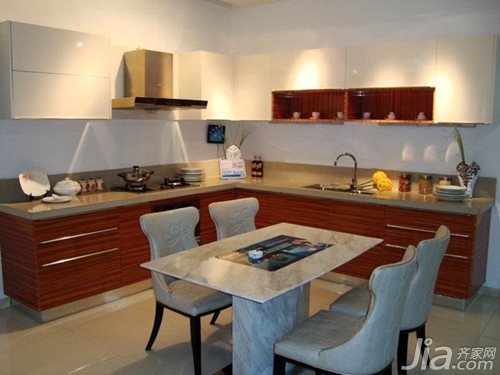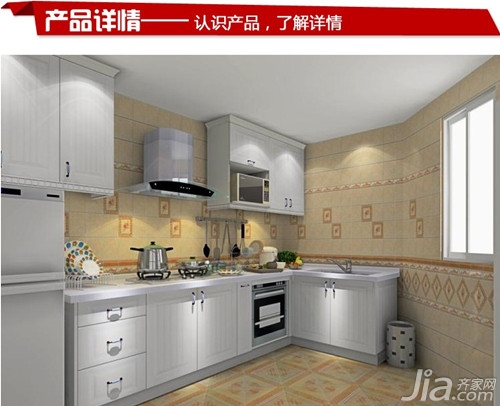We all know that when the size of goods purchased is not correct, either it cannot be used, or we must cut it out. Anyway, it will cause economic losses. The cabinets are the same. If we buy cabinets, we do not understand the dimensions of the cabinets. It will also cause us a lot of trouble, and the appropriate size will not only save us economic expenses, but also increase the aesthetics of the cabinet. Let's look at the sizes of the kitchen cabinets and the size of the whole cabinet today.

Kitchen cabinet size
Standard kitchen cabinet size cabinet
The height of the cabinet hanging cabinet is preferably 500mm~600mm, and the depth is 300mm~450mm, the length is 1200mm~3900mm, and the interval between the cabinets is preferably not more than 700mm.
The cabinet wall cabinet should be 1450mm to 1500mm from the ground. This height is suitable for the height of most cooks, so that they can open cabinets and take out containers without stomping.
The distance between the cabinet cabinet and the console is 600mm. This distance refers to the distance from the console to the bottom of the cabinet so that some utensils or small kitchen appliances can be placed.

Standard kitchen cabinet size paint cabinets
Floor height: 845mm
Water blocking height: 45mm
Front skirt height 45mm
Table width: 600mm
Hanging cabinet height: 800mm
Hanging cabinet body thickness: 350mm

Standard kitchen cabinet size plastic cupboard (wood cabinet)
Space requirement: 2.5m
Floor height: 820mm
Water blocking height: 50mm
Front skirt height: 60mm
Table width: 600mm
Hanging cabinet height: 750mm
Hanging cabinet body thickness: 380mm

Overall cabinet size
Common cabinets currently on the market, the normal height should be 820mm ~ 850mm, table width should be 550mm ~ 600mm, wall cabinet height is usually 688mm ~ 720mm, there are 800mm, 850mm, 900mm, of course, these sizes are to add money . The depth of the cabinet is usually 330mm~350mm. This is just reference data. The height of the cabinet can be designed according to your own situation.
Normally the cabinet is 600 wide and 800 high; the cabinet is 320 deep and 700 high (excluding the top line)
Each manufacturer is somewhat different (marked in mm): common floor depth 550, height 650, length single door 200, 250, 300, 350, 400, 450, 500, 600. Double door length 600, 700, 800 , 900, 1000. Cabinet deep 300, 700 or 800 high, long with the cabinet, a single door 50, a double door 100. Countertop depth 600, front elevation 40,60.
The manufacturer of standard size can produce standard cabinets in advance, produce door panels according to orders, shorten the delivery period, and also install the matching standard function hardware accessories and kitchen embedded appliances.
For a breakfast table with a height of 1100mm, this is the ideal height for the stool around it. Because there is still 300mm space between the table and the stool to accommodate the legs.
Information on the size of the cabinet was introduced here for everyone. I hope this article will be helpful to everyone. If you still have something you don't understand, you can leave a message to Xiaobian at the bottom. We will answer your questions as soon as possible.
Kitchen Cabinets Kitchen Cabinets Kitchen Cabinets Kitchen Cabinets Doors Kitchen Cabinets Doors
Ferroalloys, a broadly defined ferroalloy is a product that is used as a deoxidizer, elemental additive, etc. in steelmaking to add iron to certain properties or to meet certain requirements.
Property: The main element of the ferroalloy generally has a high melting point, or its oxide is difficult to reduce, and it is difficult to refine the pure metal. If it is together with the iron, it is easier to reduce the smelting. The use of ferroalloys in iron and steel smelting, in which iron is not only harmless, but because of the fusing of molten steel is more favorable. Therefore, deoxidation and alloying in the steelmaking process are mostly added in the form of iron alloys. Iron alloys are generally brittle and cannot be used as metal materials.
Purpose: As a deoxidizer for steelmaking, silicon manganese, ferromanganese and ferrosilicon are the most widely used . As strong deoxidizers, aluminum (aluminum iron), silicon calcium, silicon zirconium, etc are used . Commonly used alloy additives are: ferromanganese, ferrochromium, ferrosilicon, ferrotungsten, ferromolybdenum, ferrovanadium, ferrotitanium, ferronickel, niobium (neodymium) iron, rare earth iron alloy, ferroboron, ferrophosphorus and so on. A variety of ferroalloys, in accordance with steelmaking needs, are regulated in many grades based on the content of alloying elements or the level of Carbon contained, and the impurity content is strictly limited. Ferroalloys containing two or more alloying elements are called composite ferroalloys. The use of such ferroalloys can add deoxidizing or alloying elements at the same time, which is beneficial to the steelmaking process and enables the more comprehensive and efficient utilization of symbiotic ore resources. Commonly used: manganese silicon, silicon calcium, silicon zirconium, silicon manganese aluminum, silicon manganese calcium and rare earth ferrosilicon.
Ferroalloys
Ferroalloys,Ferro Silicon,Ferro Tungsten,Different Shape Ferroalloys
Hwa Seng Resources (Hong Kong) Co., Limited , https://www.hwaseng-resources.com
![<?echo $_SERVER['SERVER_NAME'];?>](/template/twentyseventeen/skin/images/header.jpg)